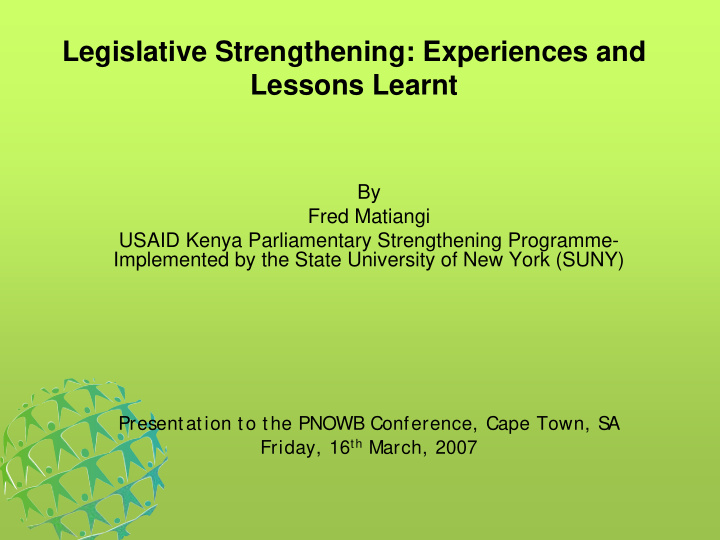



Legislative Strengthening: Experiences and Lessons Learnt By Fred Matiangi USAID Kenya Parliamentary Strengthening Programme- Implemented by the State University of New York (SUNY) Presentation to the PNOWB Conference, Cape Town, S A Friday, 16 th March, 2007
Outline • Contextualization- The Kenya Parliament in a historical perspective •Internally Driven Change: The PSC Act and the Strategic Plan for the Modernization of Parliament •The Kenya Parliamentary Strengthening Programme- (Strengthening What?) Conception to Implementation •Features of the SUNY LSP •Challenges and Lessons Learnt •What actually Works?
Context: The Kenya Parliament in a historical Perspective •The Kenya Parliament’s 3 historical phases; colonial, immediate post-colonial and the post 190s multiparty context •Background typical of half of sub-Saharan Africa’s one party regimes before the 1990s(dominated by one party, one man dominated patronage politics and rubber stamp parliaments) •Characterized by a constitutional framework (complex marriage of presidential and parliamentary systems) that marginalized the legislature and deliberately subverted it to the executive branch •Institutionally weak, poorly staffed - staff and resources heavily controlled by the executive branch. •Place in the national governance structure poorly defined, misunderstood or downrightly weakened by the neo-patrimonial and clientelism of the big man- "father of the nation” political practice (Parliament remained the household of the “father”)
Internally Driven Change: The Parliamentary Service Commission Act •Parliament still remained largely under the control of the president and the executive even after the transition to multiparty politics- a multiparty parliament under a one party state constitutional framework •Reform minded MPs working with the support of CSOs and a limited group of donors begun work on constitutional changes and a review of the law to create a commission for Parliament- It took 4 years for the desired changes to be finally enacted into law in the year 2000. •Benefits? Parliament gained autonomy over its budget, (Mps’ gained direct control of their emoluments and other forms of remuneration through the PSC) staffing and ability to work directly with actors outside of itself-CSOs, development partners etc- without the direction of the executive branch
Internally Driven Change Cont … •Parliament consequently developed a 12 year strategic plan for its modernization focusing on reforming the staff establishment, acquisition of modern library and research resources and sweeping institutional reforms to create a functioning legislative and oversight machine. •Parliament seized leadership of its own development with the enactment of the PSC. •The changes brought about by the PSC Act redefined Parliament and its role in the governance process
Legislative Strengthening Programme: The Kenyan Case •Needs assessment/survey of the a) General governance situation in the country- showed that Parliament would be a key actor in the governance process- b) Parliament itself- showed need for institutional strengthening- staff and infrastructural capacity, reform of committee system and standing orders etc •Opportunity-Parliament developed a 12 year strategic plan for the modernization of Parliament after the enactment of the PSC Act- engagement with donors and actors outside Parliament based on this strategic Plan. •Strengthening what?- Answer provided by the Parliament’s strategic Plan. Areas of development outlined in the strategic plan. USAID/SUNY based the project on the SPFMOP.
Features of the SUNY LSP •All activities/ programmes are demand –driven and negotiated with the leadership of Parliament •Delivery of most of the activities is done in collaboration with local CSO and private sector partners (example of PNOWB and PIN) •Strengthening institutional capacity- Support to committee system; committee work plans, legislative review and limited research requests •Improvement of staff capacity of Parliament- limited training of committee clerks &researchers, the Parliamentary Internship Programme •Strengthening the oversight responsibility of Parliament- Support to watchdog and money committees- pre-budget and post-budget (Finance Bill) workshops •Exposure to best practices in legislative development- study tours to other parliamentary jurisdictions
Challenges and Lessons Learnt •Accurate assessment of Parliament’s needs and their understanding that they need it- Very necessary to engage in a demand-driven relationship with Parliament •Political will and buy-in- Reforms take time to gain acceptance-patience and long term visioning necessary •Lack of conceptual clarity- Parliaments are often suspicious of ‘outside’ partners. Everything must be done to enhance confidence building •Collaboration and coordination vs ‘lone rangerism’- Donors and their CSO partners working with Parliament are often poorly coordinated. Duplication, competition and a general waste of resources often happens. •Creativity/originality in providing support to Parliament- Exporting legislative models from elsewhere is NOT legislative strengthening. •Sustainability- Building local coalitions and beefing up local (CSO, think tanks, private sector) involvement with Parliament could eventually help the legislative institutions.
What actually Works? •Accurate understanding of the socio-political and historical context •Broad ownership of the LSP in Parliament (Target constituency building) •Demand-driven approach •Collaborative methodology- Identification of institutions with core competencies/experience to provide leadership •Strong confidence building in Parliament •Better coordination amongst the actors outside Parliament
Conclusion For democracy to deepen and to contribute to social cohesion of societies, parliaments are essential building blocks. (Roel Von Meijenfeldt- IMD). This explains why focused and coordinated investment should go to Parliaments for them to play their governance role effectively. Asante Sana (Thank you)
Recommend
More recommend